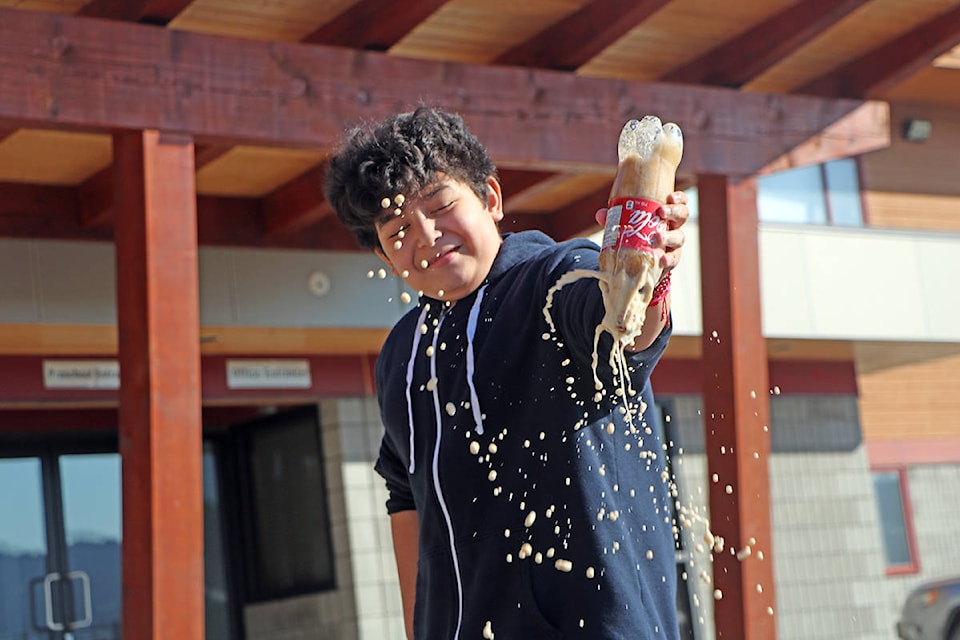Sacred Heart Catholic School’s gymnasium was abuzz with excitement on Wednesday, Feb. 19 for their annual Sacred Heart Science Fair.
All told over 40 students, working alone and in pairs, crowded the gym with science projects ready to be judged by around 20 members of the Williams Lake community such as Carol Ann Taphorn to Williams Lake RCMP Inspector Jeff Pelley. Projects were as creative as they were varied with understandings of chemistry, biology, psychology, botany and more all on display.
For Sacred Heart’s principal, Vanessa Fer, seeing how excited her students were at the prospect of sharing their knowledge with adults and one another was heartwarming to see. Fer said that, as with previous years, every student from Grades 4 to 7 have taken part in the science fair and have put about four weeks of in-class and after school work into their projects. This year she was also particularly happy they had a few more judges than usual and that they came from all parts of the City of Williams Lake.
She herself said she wasn’t able to go down an aisle of projects without at least one student asking her if she wanted to learn how their project worked. Some of her students, Fer said, are already thinking about where they can go next with their projects and ideas, which is what this fair was all about.
“At our school, we very much strive to help all of our students reach their fullest potential and we are fortunate to have the staff and parent support in place (to make that happen) and keep growing with all this loveliness,” Fer said.
One of the students taking part in the science fair was Hailey Sherlock, a Grade 7 student who said she likes science a lot. She came in third place at last year’s science fair and made it to the regional science fair, where she again came in third place along with her friend, Aubriegh Gentles. Last year, together with Gentles, she did a project on chocolate and this year she decided to do one on people’s favourite candy.
“It’s basically testing to see what people’s preference of candy is (based on colour and taste,)” Sherlock said.
To gather data Sherlock surveyed two groups of people, those under the age of 18 and those over the age of 18, and asked them to pick their favourite candy based on colour. Sherlock went in assuming those under 18 would pick red-coloured candy due to its flavour while those over 18 would be more likely to pick black candy because, as humans get older, they have less taste buds.
Read More: New indoor treehouse delights Sacred Heart Preschoolers
“I had to collect the data very carefully because if I didn’t I’d get my charts wrong because there were so many parts of the project that were tricky to record. I ended up making the observation chart three times because I kept on doing it wrong,” Sherlock giggled.
One issue she ran into was the colours of different candies didn’t always match the flavours, as red could be both strawberry or cherry, for example.
Despite these issues, she said it was super fun, even if finding children to test was easier than adults while at school. Her test group was made up of 30 different students and 30 different adults while she used candies like jube jubes, jelly beans and Skittles.
In the end, Sherlock said she learned that red-flavoured candy was the favourite for adults and children while black is the least favourite for children and yellow is the least liked for adults. With both groups’ results pooled together, Sherlock found red is the overall favourite while yellow is the least favourite.
In her opinion, doing science projects like this are super fun and fills people with confidence and a chance to meet some cool people.
One of the lead judges for the science fair was Clinton Webb, a land and resource specialist for the forests ministry, who has been a judge at the fair six times to date. Webb feels it’s an important opportunity for kids to try their hand at science topic that interests them and develops the discipline required to meet their project’s deadline.
In addition to getting to coming up with the idea for their own projects and getting to develop them, Webb feels it’s important they then have to explain the project to judges one on one. The main thing the judges look for is enthusiasm and signs that the children completed the project on their own, Webb said, by looking for things like spelling mistakes.
“Science reinforces, for children, the importance of basing their ideas and opinions on information. It’s not just taking other people’s word for what is going on in the world, it’s them investigating for themselves and coming to their own conclusions.”
patrick.davies@wltribune.com
Like us on Facebook and follow us on Twitter
